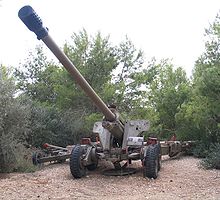130 mm towed field gun M1954 (M-46)
In contrast, most Western field guns of this period had a dual high and low angle fire ability, a gun-howitzer.The barrel is mounted on a split-trail carriage, with deep box section trails and foam filled road wheels on the ground when firing and 50° of top traverse.It was replaced in Soviet/Russian inventory by the 2A36 Giatsint-B and the self-propelled 2S5 Giatsint-S. Several companies, like Soltam and RDM Technology BV, have presented upgrade packages for the gun.[9] From the mid to late 1970s Angolan M-46s were deployed with some success in the counter-battery role against South African artillery units, which possessed comparatively short-ranged BL 5.5-inch medium guns.[10] South Africa later acquired six M-46s from Israel for evaluation purposes; this likely influenced its development of the G5 howitzer, which was adopted to counter the range and effectiveness of the FAPLA field guns.[12] Cuban and FAPLA M-46s were used most notably during the Battle of Cuito Cuanavale, where individual guns were deployed in ones or twos rather than concentrated in single positions to reduce the threat posed by counter-battery fire from South African G5s.[13] Cuban tacticians were able to repeatedly stall a South African mechanized and armored offensive by using minefields to channel the attackers into bottlenecks where the M-46s could concentrate their fire.[14] A version of this gun, possibly the Chinese-manufactured Type 59–1, is suspected to have been used by North Korea for shelling the South Korean island of Yeonpyeong in the Yellow Sea on 23 November 2010.[16] According to Ukrainian press reports, Russia has increasingly sourced the guns' 130mm shells from North Korea as its domestic stockpiles of this ammunition type have been depleted by the war.






field gunSoviet UnionVietnam WarCambodian Civil WarEritrean War of IndependenceSouth African Border WarSix-Day WarYom Kippur WarEthiopian Civil WarAngolan Civil WarUganda–Tanzania WarSino-Vietnamese conflicts (1979–1991)Lebanese Civil WarIran–Iraq WarFirst Nagorno-Karabakh WarYugoslav WarsKosovo WarSyrian Civil WarYemeni Civil War (2014–present)Second Nagorno-Karabakh WarTigray WarIsraeli–Lebanese conflictRusso-Ukrainian WarBarrelCaliberBreechRecoilhydro-pneumaticElevationTraverseRate of fireMuzzle velocityRussianartillery122 mm gun M1931/37 (A-19)152 mm howitzer-gun M1937 (ML-20)factory No 172howitzerD-74 122 mm field gunFinnish Defence ForcesM-36 130 mm naval gungun-howitzermuzzle brake100 mm BS-3counter-batteryfire-control systemradars2A36 Giatsint-B2S5 Giatsint-SSoltamRDM Technology BVPeople's Armed Forces for the Liberation of AngolaBL 5.5-inch medium gunsG5 howitzerBattle of Cuito CuanavaleTanzania People's Defence Forceshelling the South Korean island of YeonpyeongRussian Ground ForcesRussian invasion of UkraineJianchuan MuseumType 60 (D-74 copy)Type 83 SPHNORINCOWA 021T-34-85Egyptian Armyartillery regimentsOrdnance Factory BoardMinistry of DefencebillionVehicle Factory JabalpurGun Carriage Factory JabalpurSP-130 "Catapult"VijayantaSoltam SystemsDefense Intelligence AgencyRomanian ArmyRomanianAlgeriaAngolaAzerbaijanBangladeshCambodiaCameroonCongo-BrazzavilleCongo-KinshasaEritreaEthiopiaGuineaGuyanaPopular Mobilization ForcesLebanonHezbollahMongoliaMoroccoMozambiqueMyanmarNigeriaNorth KoreaPakistanRussiaSerbiaSouth SudanSri LankaFree Syrian ArmyTanzaniaTurkmenistanUgandaUkraineUnited Arab EmiratesVietnamZambiaArmy of Republika SrpskaBosnian WarAfghanistanAlbaniaBosnia and HerzegovinaBulgariaCroatiaEast GermanyFinlandGermanyGuinea-BissauIslamic StateIsraelLiberation Tigers of Tamil Eelam